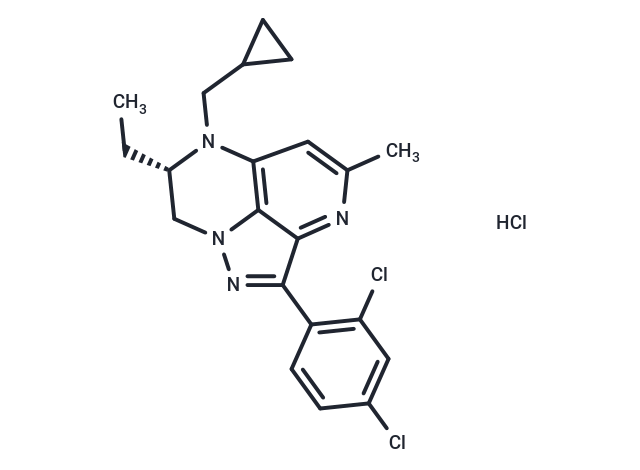Shopping Cart
- Remove All
 Your shopping cart is currently empty
Your shopping cart is currently empty

NBI 35965 hydrochloride is a selective CRF1 (corticotropin-releasing factor receptor 1) antagonist that is both orally active and capable of penetrating the brain. It possesses a K i value of 4 nM and a pK i of 8.5, and does not affect CRF2. This compound effectively diminishes CRF or stress-triggered ACTH (adrenocorticotropic hormone) production in vivo, demonstrating pIC 50 values of 7.1 and 6.9. Additionally, NBI 35965 hydrochloride exhibits anxiolytic properties [1] [2].

| Pack Size | Price | Availability | Quantity |
|---|---|---|---|
| 10 mg | Inquiry | 10-14 weeks | |
| 50 mg | Inquiry | 10-14 weeks |
| Description | NBI 35965 hydrochloride is a selective CRF1 (corticotropin-releasing factor receptor 1) antagonist that is both orally active and capable of penetrating the brain. It possesses a K i value of 4 nM and a pK i of 8.5, and does not affect CRF2. This compound effectively diminishes CRF or stress-triggered ACTH (adrenocorticotropic hormone) production in vivo, demonstrating pIC 50 values of 7.1 and 6.9. Additionally, NBI 35965 hydrochloride exhibits anxiolytic properties [1] [2]. |
| Targets&IC50 | CRFR1:8.5 (pKi), CRFR1:4 nM (Ki) |
| In vitro | NBI 35965 hydrochloride exhibits high affinity for CRF1 and lacks binding affinity for CRF2. Additionally, in CRF1-transfected cells, NBI 35965 hydrochloride can inhibit Sauvineine-induced cAMP stimulation [2]. |
| In vivo | NBI 35965 hydrochloride, when administered orally at a dose of 20 mg/kg, reduces stress-induced ACTH production in mice [1]. In rats, NBI 35965 hydrochloride (compound 12a; 10 mg/kg) exhibits a volume of distribution of 17.8 L/kg, a plasma clearance rate of 17 mL/min/kg, and a half-life of 12 hours. Its estimated oral bioavailability is 34%, with an average maximum plasma concentration of 560 ng/mL occurring at 1 hour post-administration. This compound is also capable of crossing the blood-brain barrier, achieving an average peak brain concentration of 700 ng/g [1]. Animal Model: Male CD-1 mice (24-26 g) subjected to restraint stress [1] Dosage: 20 mg/kg (10 mL/kg 5% mannitol-d (w/v) in water) Administration: Oral gavage, 60 minutes before stressor initiation Result: Decreased stress-induced ACTH production in vivo. |
| Molecular Weight | 437.79 |
| Formula | C21H23Cl3N4 |
| Cas No. | 1782228-59-4 |
| Storage | Powder: -20°C for 3 years | In solvent: -80°C for 1 year | Shipping with blue ice. |

Copyright © 2015-2025 TargetMol Chemicals Inc. All Rights Reserved.